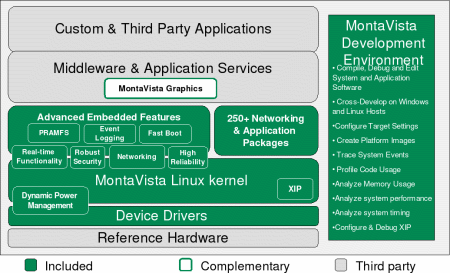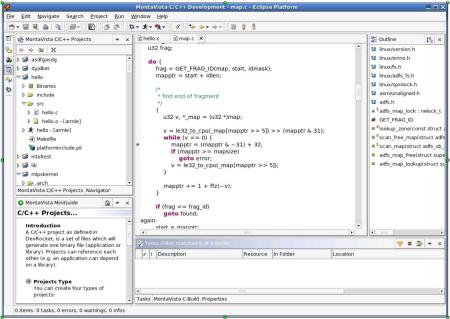MontaVista updates its consumer electronics Linux
Feb 23, 2004 — by LinuxDevices Staff — from the LinuxDevices Archive — 4 viewsMontaVista Software has released a substantial update to its Linux distribution for consumer electronics devices, the first major revision since its introduction one year ago. Version 3.1 of MontaVista Linux Consumer Electronics Edition (CEE) provides general Linux updates, security and reliability enhancements including… a new high-security filesystem, faster boot and application launch times, and support for MontaVista's Eclipse-based “DevRocket” development tool, according to Scott Hedrick, product manager for MontaVista Linux CEE.
Hedrick notes that the release comes at a time of growing momentum for MontaVista and embedded Linux in general. “For example, we're working with half a dozen vendors on cell phones, and we expect from half a dozen to over a dozen phones based on CEE to ship by the end of this year,” Hedrick says.
Motorola's A760 and A768 are the first mobile phones based on MontaVista Linux to reach the market. Both of these models are dual-band GSM phones, and so can't be used in the US. However, Hedrick predicts that several Linux phones based on CEE will ship in the US this year.
In addition to cell phones, MontaVista Linux CEE has been used to build digital video recorders (DVRs), voice-over-IP (VoIP) phones, high-definition televisions (HDTVs), media servers, and residential gateways (see “Device Gallery” below). Hedrick notes that the Consumer Electronics Linux Forum (CELF) “has rapidly become a 'who's who' of the world's leading device manufacturers, and most of them are customers of MontaVista.”
One size fits all
Despite efforts by embedded software rivals such as Wind River (see story), Microsoft, and Metrowerks (see story) to target specific embedded market segments with application-oriented software solution stacks for PDAs, smartphones, residential gateways, set-top boxes, etc., Hedrick says MontaVista intends to stick with generic consumer electronics solutions in order to address the broadest possible customer base in the consumer device space.
While Hedrick doesn't rule out the possibility of, say, a MontaVista cell phone application stack, he says it isn't a priority. “We've seen that a lot of the companies that have tried to focus too much on verticals are gone — Lineo, Ridgerun for example [see stories here and here –ed]. The requirements of the market are too different. Each customer has their own preferred Java, or browser provider. If we pick one, that affects our ability to sell.”
In terms of satisfying the software requirements of various specific consumer electronics applications, Hedrick emphasizes the strength of the MontaVista “partner ecosystem,” which now numbers more than 270 software vendors and solution providers. “Since we're not a complete solution provider, we rely on a lot of partners,” he notes.
Linux updates
MontaVista CEE 3.1 (see figure, below) is based on a Linux “2.4.20-plus” Linux kernel, according to Hedrick. “Later versions in the 2.4 kernel series actually introduced additional problems as well as providing improvements,” says Hedrick. “So, we [incorporated] the best of later versions of Linux [along with] our own value add from tuning” into the 2.4.20 kernel.
Hedrick notes that CEE 3.1 does include the latest GNU toolchains, however. And, while MontaVista earlier said it would wait before moving to kernel 2.6, Hedrick confirmed the company does expect to ship a version of CEE based on 2.6 “this year.”
Despite being based on an earlier kernel, CEE 3.1 does include features from the 2.6 kernel, including the much-publicized pre-emptible kernel patch developed and contributed by MontaVista. It also supports “dynamic power management” technology that was recently released under the GPL by MontaVista.

System architecture, MontaVista Linux CEE 3.1
(Click to enlarge)
Security and reliability enhancements
CEE includes a brand new, high security “protected RAM filesytem” (PRAMFS) targeting applications where critical data must not be overwritten or corrupted. According to Hedrick, PRAMFS minimizes opportunities for errant writes that can corrupt file system data in system RAM. He cites the storage of phone numbers in cell phones or operator information in set-top boxes as typical applications. PRAMFS was among several technologies that MontaVista recently released under the GPL.
CEE 3.1 also offers “event logging” features based on the event broker re-purposed from MontaVista's Carrier Grade Edition. This feature provides system recovery support, according to Hedrick.
New “thread stack guard pages” in CEE 3.1, meanwhile, enhance security and reliability by protecting against buffer overflow conditions from code errors.
Performance enhancements
According to Hedrick, CEE 3.1 comes pre-configured to boot in less than a second, using XIP (eXecute In Place) technology. “As far as I know, we're the first to offer commercially supported XIP,” notes Hedrick.
In order to support faster application launching, the new release also includes a tool for pre-linking dynamic libraries. “Improved data alignment,” meanwhile, reduces memory footprint while improving memory accounting accuracy, the company claims.
CEE 3.1 also features “improved data alignment,” which Hedrick says reduces memory footprint while improving memory accounting accuracy.
According to Hedrick, CEE 3.1 already supports much of the CELF specification, a set of formalized requirements for extensions to Linux to meet the needs of consumer electronic (CE) products. And, Hedrick says, MontaVista will continue to enhance CEE to meet the full CELF specification.
New development tool support
The new release adds support for MontaVista's Eclipse-based development tool, DevRocket. DevRocket for CEE 3.1 is designed for system software and application development, according to Hedrick, and provides common development environment capabilities such as compile, edit, debug, and revision control. It also features a new graphical installation and configuration tool.
DevRocket supports development hosted on Linux, Solaris, and Windows, and provides a common GUI across all host platforms, Hedrick says. For Windows users, MontaVista Linux CrossTools for Windows provides network file sharing and support network-booting the target.
DevRocket also provides a common GUI for development tools, including Eclipse plug-ins available from MontaVista and others utilizing the Eclipse platform for cross-vendor tools integration.

MontaVista's DevRocket, being used for C/C++ development
(Click for larger view)
In terms of specific support for CEE 3.1, DevRocket offers integrated “system tools” for timing, sizing, and performance measurement and tuning. It also offers XIP debug support, as well as a range of “target tools” that provide system information and logging in a graphical environment rather than on a system console. Target tools include:
- View and change process priority
- Soft reboot target
- Download to flash
- Syslog viewer
- Browse /proc
- Run commands and view output
DevRocket was first introduced in November, 2003, along with the 3.1 release of MontaVista Linux Professional Edition.
Availability
MontaVista Linux CEE 3.1 has undergone in-house testing and beta testing at customer sites as part of MontaVista's early access program, according to Hedrick, and is available now in a fully supported “general availability” release. Further details can be found on MontaVista's website.
Below are brief descriptions of a few of MontaVista's recent design wins in the consumer electronics industry . . .
-
 Sony Cocoon — an Internet-connected Personal Video Recorder (PVR).
Sony Cocoon — an Internet-connected Personal Video Recorder (PVR).
-
 Sharp Galileo — Galileo combines personal video recorder (PVR) and video on demand (VOD) functions with wireless access point, broadband gateway, and set-top box features, and is the flagship product in Sharp's vision of a connected ubiquitous home network.
Sharp Galileo — Galileo combines personal video recorder (PVR) and video on demand (VOD) functions with wireless access point, broadband gateway, and set-top box features, and is the flagship product in Sharp's vision of a connected ubiquitous home network.
-
 Philips iPronto — “The iPronto combines audio/video, home automation, and home network control capabilities in an easy-to-manage device that offers consumers a new solution for controlling a wide range of devices in the connected home,” according to Philips. Winner of 2003 CES “Best of Show” award.
Philips iPronto — “The iPronto combines audio/video, home automation, and home network control capabilities in an easy-to-manage device that offers consumers a new solution for controlling a wide range of devices in the connected home,” according to Philips. Winner of 2003 CES “Best of Show” award.
-
 Matsushita/Panasonic “Broadnow” TV tuner — The first in a new Matsushita family of broadband-connected TV products that offer consumers access to high-quality video, music, and other content over broadband networks such as fiber-to-the-home (FTTH) and ADSL, with advanced features such as remotely controlling video recording via email.
Matsushita/Panasonic “Broadnow” TV tuner — The first in a new Matsushita family of broadband-connected TV products that offer consumers access to high-quality video, music, and other content over broadband networks such as fiber-to-the-home (FTTH) and ADSL, with advanced features such as remotely controlling video recording via email.
-
 NEC AX10 — A unique “TV in a PC” that lets consumers view, listen, edit, and save TV programs onto a hard disk or videotape. Users can record broadcast content when they are away from home, controlled via an i-mode cellular phone. It also can connect personal PCs in a home network (wireless, Ethernet, etc.) with a variety of audio-visual equipment, and can distribute recorded content to every TV or PC in the home.
NEC AX10 — A unique “TV in a PC” that lets consumers view, listen, edit, and save TV programs onto a hard disk or videotape. Users can record broadcast content when they are away from home, controlled via an i-mode cellular phone. It also can connect personal PCs in a home network (wireless, Ethernet, etc.) with a variety of audio-visual equipment, and can distribute recorded content to every TV or PC in the home.
-
 Panasonic broadband phone — Next-generation, integrated, multi-function IP phone and Internet terminal that includes a wide LCD display, Internet connectivity with touch screen operation, and handwriting input for email messages. The terminal also incorporates touch screen operation of phone functions such as message answering, number display, and ring melody selection.
Panasonic broadband phone — Next-generation, integrated, multi-function IP phone and Internet terminal that includes a wide LCD display, Internet connectivity with touch screen operation, and handwriting input for email messages. The terminal also incorporates touch screen operation of phone functions such as message answering, number display, and ring melody selection.
-
 Volvo ITS4mobility — ITS4mobility, is an Intelligent Transport System (ITS) integrated with a Real-Time Passenger Information (RTPI) system that enables tracking of bus locations, two-way messaging, bus arrival forecasts, and other valuable functions. It can even provide “traffic control” capabilities, by signaling to traffic lights and requesting priority treatment!
Volvo ITS4mobility — ITS4mobility, is an Intelligent Transport System (ITS) integrated with a Real-Time Passenger Information (RTPI) system that enables tracking of bus locations, two-way messaging, bus arrival forecasts, and other valuable functions. It can even provide “traffic control” capabilities, by signaling to traffic lights and requesting priority treatment!
-
 Motorola A768 — A Linux-powered smartphone targeting enterprise customers now shipping in China.
Motorola A768 — A Linux-powered smartphone targeting enterprise customers now shipping in China.
-
 Motorola A760 — The first fruit of Motorola's strategy to base many high-end phones and connected devices on a software platform comprising Linux and Java.
Motorola A760 — The first fruit of Motorola's strategy to base many high-end phones and connected devices on a software platform comprising Linux and Java.
This article was originally published on LinuxDevices.com and has been donated to the open source community by QuinStreet Inc. Please visit LinuxToday.com for up-to-date news and articles about Linux and open source.